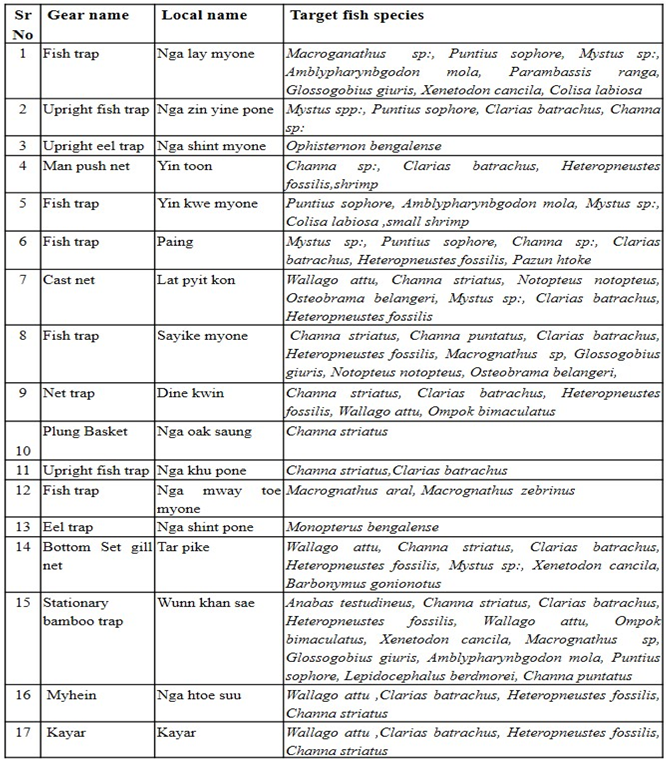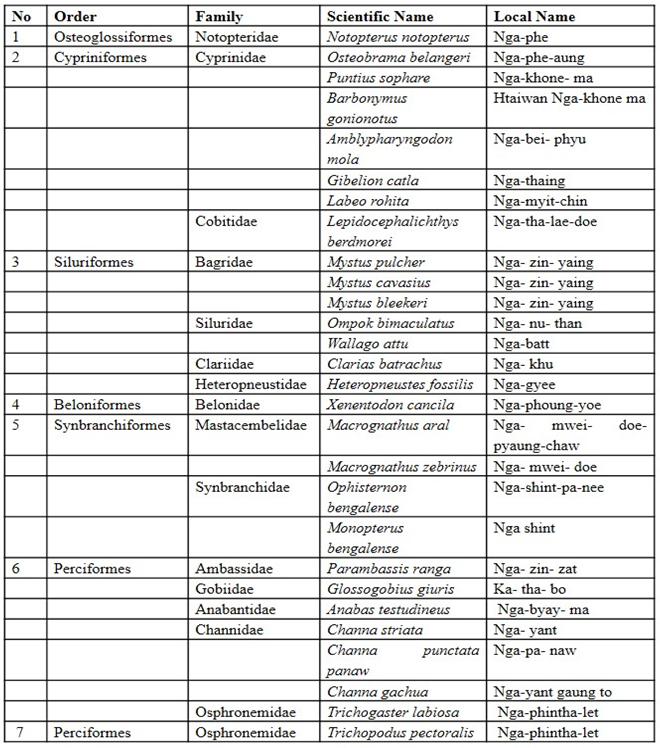-
Paper Information
- Paper Submission
-
Journal Information
- About This Journal
- Editorial Board
- Current Issue
- Archive
- Author Guidelines
- Contact Us
Resources and Environment
p-ISSN: 2163-2618 e-ISSN: 2163-2634
2020; 10(2): 27-32
doi:10.5923/j.re.20201002.02
Received: June 23, 2020; Accepted: July 25, 2020; Published: August 15, 2020

Investigation of Fishing Gears and Species Diversity of Fishes in Moe Yun Gyi Constructed Wetland, Bago Region, Myanmar
Hsu Htoo 1, 2, Phyoe Marnn 3, Nizeyimana Jean Claude 3, Khin Swe Wynn 4, Aye Aye Kyu 4, Yousef A. Al-Masnay 3, Haider Ali 3
1Transgenic Research Center, School of Life Science, Northeast Normal University, Changchun, China
2Department of Zoology, University of East Yangon, Yangon, Myanmar
3School of Environment, Northeast Normal University, Changchun, China
4Department of Zoology, Bago University, Bago, Myanmar
Correspondence to: Phyoe Marnn , School of Environment, Northeast Normal University, Changchun, China.
| Email: |  |
Copyright © 2020 The Author(s). Published by Scientific & Academic Publishing.
This work is licensed under the Creative Commons Attribution International License (CC BY).
http://creativecommons.org/licenses/by/4.0/

The Moe Yun Gyi construction wetland is located in Bago village in Bago region and selected as our research area. Located on the Mandalay Highway from 16° 45' North latitude, 95° 34' East longitude, 25km Northeast of Bago and East of Yangon. The assessment of fish species based on the types of the fishing gear and their performance in the Moe Yun Gyi constructed wetland and its environs of Bago region. The paper provides the definitions of fishing gears used by locals, grouped by categories, following the classification in accordance with the recognized standard by the F.A.O for the small, medium, and large scale fisheries in the study area. This study work was discovered from January 2018 to December 2018. The data were obtained by interviewing the local fishermen used various kinds of fishing gears depending upon their respective income, seasonal hydrological condition, and the habitat of fishing ground. The survey revealed total 17 different types of fishing gears and a total of 22 species of 28 species, and 16 families of 7 orders were recorded throughout the year in the study area. Conclusion: The fishes of the wetland and river were under pressure by different non-selective, illegal and restricted fishing gears. So, scientific based management is prerequisite to guide the fish fauna for near extinction.
Keywords: Fishing gear, Fish Species, Moe Yun Gyi constructed wetland, Species, Genera, Families, Orders
Cite this paper: Hsu Htoo , Phyoe Marnn , Nizeyimana Jean Claude , Khin Swe Wynn , Aye Aye Kyu , Yousef A. Al-Masnay , Haider Ali , Investigation of Fishing Gears and Species Diversity of Fishes in Moe Yun Gyi Constructed Wetland, Bago Region, Myanmar, Resources and Environment, Vol. 10 No. 2, 2020, pp. 27-32. doi: 10.5923/j.re.20201002.02.
Article Outline
1. Introduction
- Myanmar, the northernmost country of Southeast Asia, shaped like a kite with a long tail that runs south along the Malay Peninsula. There is China in the north and northeast part of the country and in the east and southeast of the country is bordered by Laos and Thailand, where Bangladesh is located in the west, and India in the northwest. Its total length from north to south is about 1,275 miles (2,050 km), and its width at the widest part, across the center of the country at about the latitude of the city of Mandalay, is approximately 580 miles (930 km) from east to west.Myanmar is rich in natural resources where Agriculture, Forestry and fishing drive the largest part of the Myanmar economy. Among them, incomes from aquaculture, farming fish stands at third stage after rice and agriculture. The benefits of farmed fish are 5 to 10 times higher than farming paddy fields and other agricultural crops. Every household in Myanmar use their money in fish about 14% and rice about 19%.The freshwater capture fisheries is the most impressive in Myanmar. The inland freshwater bodies cover 8.1 million hectares, which 1.3 million hectares are permanent, the remainder are seasonally inundated floodplain which are the Ayeyarwaddy (2150km long), Chindwin (844km) and Sittaung (563km) and finally the large Thalwin River (2400lm) to the east. All of them have adjacent deltas and are arguably part of a larger joint system. In this study, fish species from the Moe Yun Gyi constructed wetland is located in the Bago sub-district next to the Yangon-Mandalay Highway, about 70 miles north of Yangon. It is only 2 hour drive from Yangon. In 1878, a reservoir was built in Moe Yun Gyi area. A few years later the reservoir naturally turned into a wetland and occupied an area of 40 square miles with high wetland protection value. As a result, wetlands have been designated as wildlife sanctuaries since 1988 (http://www.moeyungyiwetlandsresort.com/). Inland capture fisheries can be divided into two main categories- Inn and open fisheries. Recently the demand for fish have increased in line with population growth resides along the coast of the river and nearby village. As a result, the number of fishermen fishing both for subsistence and for employment has increased in figures. This together with the introduction of more efficient fishing gears, caused the size of the catch to dwindle as wild fish stocks of the river became threatened by over-fishing. Besides, water pollution from point and nonpoint sources, construction of dams by local government, siltation, river erosion, agricultural runoff, industrialization, oil discharged from launch, streamer and mechanical fishing vessels, human encroachment, recreational activities and finally indiscriminating catching of fish fry and juvenile through small mesh sized gears are also the added up factors probably responsible for declining of fish fauna from the river (Mohsin, 2014).However, there is not satisfactory information found in the literature regarding the recent fish fauna and fishing gears used to capture fish of the river. Therefore, it is central aspect to conduct scientific investigation on available fishing gears including their mesh size and catch composition of respective gears, fishing crafts and diversity of fish fauna to understand the ecosystem of the rivers (Rahma, 2015).Over the years, unsustainable fishing methods have greatly affected people’s fish supply and food security. Aquatic products are mainly used for food, and other uses are for animal feed and fertilizers. Traditionally, fishing gears used for inland fishing was developed in small-scale fishing activities. The most widely used fishing gears are fish trap, upright fish trap, upright eel trap, man push net, plung basket, drop door trap, fish trap, cast net, net trap, drift gill net, set gill net, shallow bamboo stake trap, stationary bamboo trap, stationary bamboo fish filter in the study area (FAO, 1996).Myanmar has impressive freshwater capture fisheries. The inland waters are made up mainly of the intelocking/ mingling of riverine and estuarine systems of the Ayeyarwaddy (Irrawaddy, 2 150 km long), Chindwin (844 km; a tributary of the main Ayeyarwaddy) and Sittaung (563 km) rivers, plus the large Thalwin River (2400 km) to the east. The first three have adjacent deltas and are arguably part of a larger joint system. Together these systems extend from the eastern part of the Bay of Bengal to the Gulf of Moattama and along the eastern edge of the Andaman Sea. The Ayeyarwaddy River alone has a mean discharge of 13 500 m3/second from its catchment of 424 000 km2 (Welcomme, 1985), notably, practically all within Myanmar. Aquatic resource area of the river systems within Myanmar encompasses a total of 8.2 million ha (FAO, 1996) of permanent and seasonal water bodies and there were 29 000 ha of freshwater fishponds and a further 40 716 ha of shrimp ponds in 2001, and 115 687 ha of reservoirs (see Table 1). The Department of Fisheries (DoF) in Yangon estimates a figure of six million ha of floodplains, which likely excludes river area and floodplain lakes. This approaches that of the entire Mekong Basin (>seven million ha, MoI, 2000).Fishing gears are quite selective and sample to use. Practically, Inland fisheries can fish all the year round but the amount of caught may vary from season to season. Fishery management requires a good knowledge of fishing gear. There is great divergence in the efficiency of different forms of fishing gear. Normally fisheries in the study area are small scales. Since the fisheries are the livelihood of the fishing villages in general, the villagers usually behave fishing in a sustainable manner. Fishers should keep their limit on their own in order to further enhancement of the stock in future. So the fishing gears are very important for the natural fisheries resources to restore and sustain (Brandt, 1984).The present study was conducted at Moe Yun Gyi wetland located in Bago Township. The present work was undertaken on the fishing gear within the selected study area with the following objectives:• To determine the types of fishing gears used in the study area• To categorize the fish species in the study area
2. Materials and Methods
- Study areaAs a study area, Bago Region, Moe Yun Gyi Wetland was chosen. It is situated at 16° 45’ N, 95° 34’ E and 25 km far from Northern East of Bago, East of the Yangon to Mandalay highway road. Moe Yun Gyi Wildlife Sanctuary (Moe Yun Gyi Wetland) lies in the North - East of Pyinbongyi village which area is 100 square kilometer. It is one of the protected and conservation areas in Myanmar.Study period The study was conducted from January 2018 to December 2018. During in this study period, the researchers investigated with a view to assessment of efficiency of fishing gears and their performance.Fish sample collectionIn this study, all of the fish specimens were collected from the fishermen. After being caught, scaled photographs were taken in order to obtain the natural size and colour. The collected species will be identified and labeled with local name before preserving them in 10% formalin. The fishing gears were recorded and taken photograph.Classification of fishing gearsThe classification of fish gears were classified based on Nedelec and Prado (1990) and Deap, Dengen and Van Ialinge (2003).Identification of fish speciesIdentification of fish species were followed after by Jayaram (1981), Talwar and Jhingran (1991), Rainboth (1996) and Ferraris Jr. (1997).
3. Results & Occurrences
- Recording of utilized fishing gears and methodsThe fishing gears and methods utilized in the study area were recorded together with target fish species and identified according to Brandt (1984), FAO (1990) and fish base (2019).Seventeen kinds of fishing gears recorded in the study area. They are Fish trap, Upright fish trap, Upright eel trap, Man push net, Fish trap (Yin kwe myone), Fish trap (Paing), Cast net, Fish trap (Sayike myone), Net trap, Plung Basket, Upright fish trap, Fish trap, Eel trap, Bottom Set gill net, Stationary bamboo trap, Myhein and Kayar. (Plate 1 and 2 and Table 1).
|
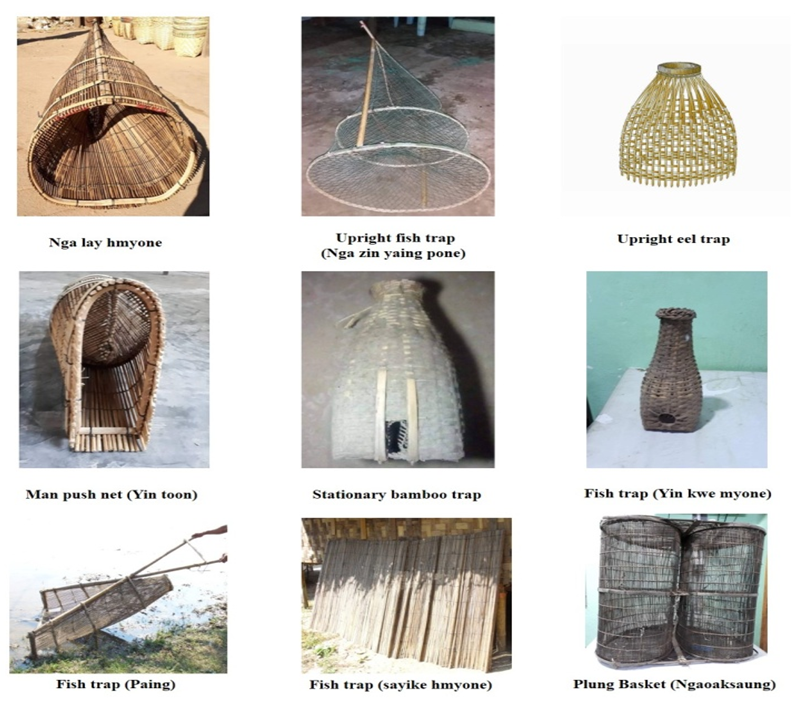 | Plate (1). Fishing gears utilized in the study area |
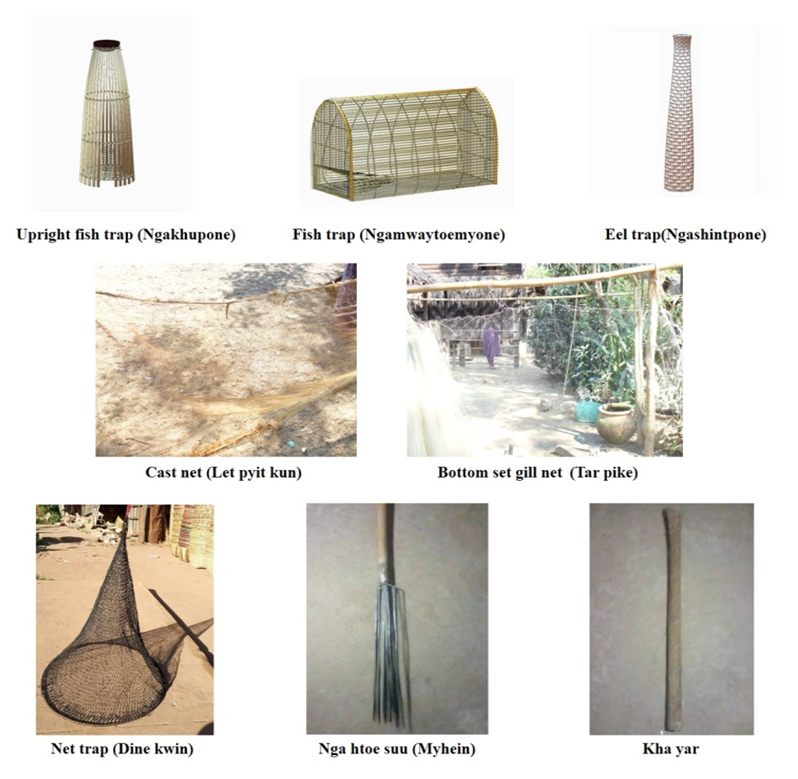 | Plate (2). Fishing gears utilized in the study area |
|
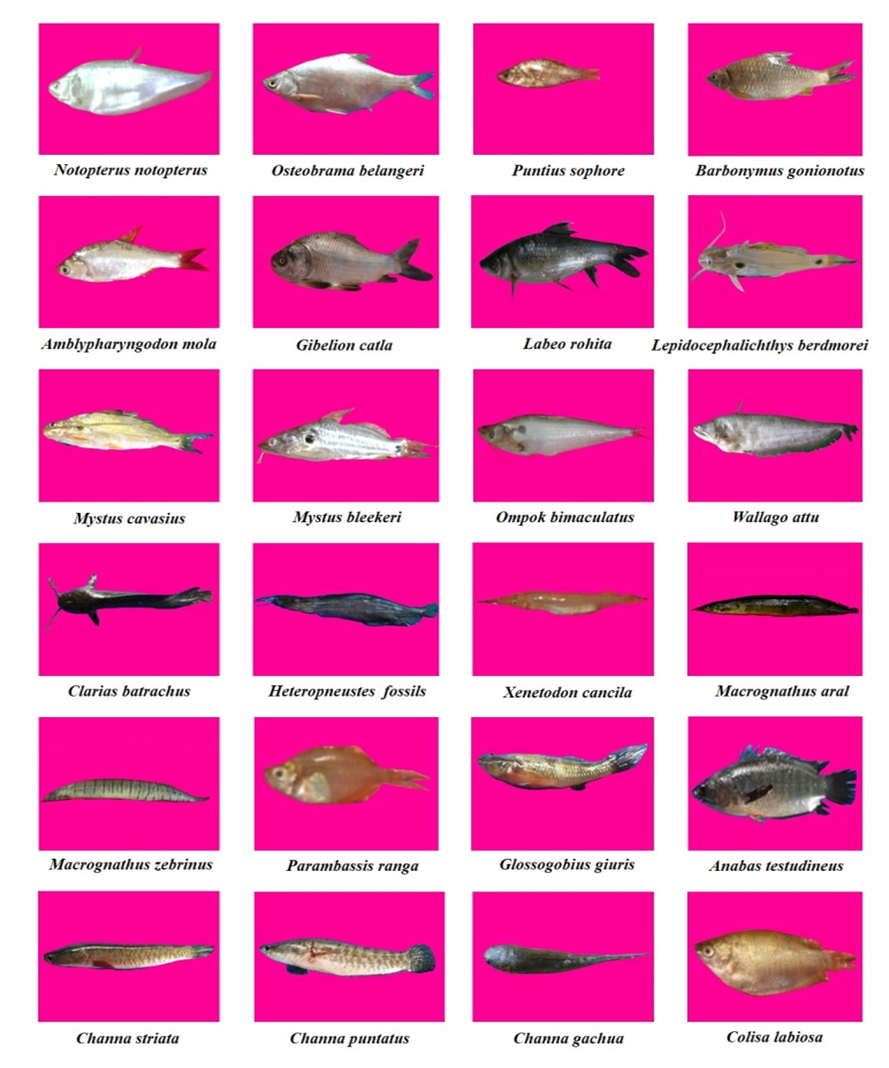 | Plate (3). Recorded fish species in the study area |
4. Discussion & Conclusions
- In Myanmar, there are many kinds of fish species both inland and marine water with 291 species in freshwater and 463 species in brackish as well as marine water (Fishbase, 1996). A total of twenty eight fish species were caught by seventeen kinds of fishing gears were recorded in the study area.Most of the fishing activities were found during dry season after water level was receded. All fishermen in the study area do small enterprise by using various types of fishing gears for their families’ consumption and income. In the study area, fishers have been used Fish trap, Upright fish trap, Upright eel trap, Man push net, Fish trap (Yin kwe myone), Fish trap (Paing), Cast net, Fish trap (Sayike myone), Net trap, Plung Basket, Upright fish trap, Fish trap, Eel trap, Bottom Set gill net, Stationary bamboo trap, Myhein and Kayar all year round depending on water level.These fishing gears are rather selective and simple for using. However, the use of fishing gears in the Inn waters needed to be permitted by authorities according to the Freshwater Fisheries Law (1991). Practically, fishermen can fish all year round but the amount may differ from time to time. Freshwater fish is abundant during the rainy season from June to September. During this period, rivers, wetlands and flood plains are very creative as new water stimulates spawning. Yearly, fish grow to full size during rainy season and are the goal of fishing effort. After the rainy season, from October to December, water level in most inland habitats start leveling off. This enables fishers to easily access grown fish from rainy season using various fishing gears. Fishing can be done all year round in rivers and inn but fish are caught more readily from July to September when the water level is low. Several recorded fishing gears and methods are legally in Myanmar. Although freshwater fish species were widely distributed in Myanmar, the rate of fish catch rate has been declining year by year because of increasing in fishers’ populations. Aquatic population was assumed to be decreasing and threatening to aquatic biodiversity in the study area. The study indicated that community base management and educational program for local people were needed to preserve aquatic biodiversity.The fisheries area is very important in Myanmar's economy, as fish create a major source of animal protein in the food of the people. It also provides income generation to government and especially to the family economy of the rural people. The present study could not be requested to be complete but the recorded data in this work would certainly develop the information on fish fauna and fishing gears of Myanmar.
ACKNOWLEDGEMENTS
- The author would like to thank Dr Aye Aye Tun, Rector of Bago University and Dr Yin Yin Than, Pro-Rector of Bago University, who had encouraged and gave suggestions for this paper and U Sai Kyaw Myint and U Moe Kyaw for their invaluable insights into aquaculture taxonomy and comments on the working draft.
 Abstract
Abstract Reference
Reference Full-Text PDF
Full-Text PDF Full-text HTML
Full-text HTML